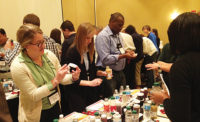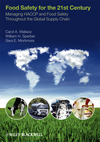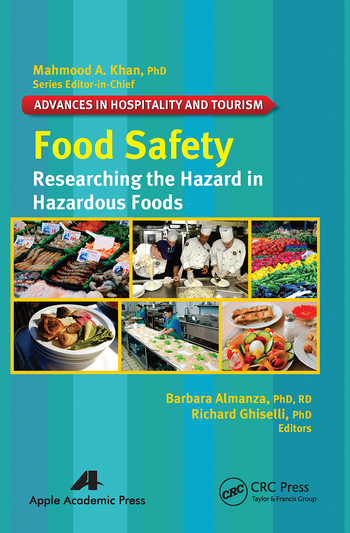Food Science Meets Food Safety
As consumer demand for clean label products continues to rise, processors’ use of natural antimicrobial ingredients is trending up.

SOURCE: Corbion USA/ CSM N.V. (www.corbion.com)

Sometimes, the best natural antimicrobial or preservative is derived from the main ingredient of the formulation, such as malic acid from apples, in products like apple cider.
SOURCE: Crispin Cider Co. (www.crispincider.com)

Rosemary extract is a powerful antioxidant that inhibits both mold and bacteria; it also extends shelflife and preserves color.
SOURCE: Malabar Super Spice Co. Ltd. (www.malabarsuperspice.com)

SOURCE: Centers for Disease Control (www.cdc.gov)

Celery powder is a source of naturally occurring nitrates and one of the most widely used natural antimicrobial ingredients in processed meat and poultry.
SOURCE: Coleman Natural Foods LLC/The Original Brat Hans Co. (www.theoriginalbrathans.com)

Vinegar and rosemary are among those ingredients used in Sandridge Food Corp.’s new Apple Cranberry Couscous Salad Base. Sandridge also applies high-pressure processing to ensure food safety.
SOURCE: SANDRIDGE FOOD CORP (WWW.SANDRIDGE.COM)

SOURCE: BI Nutraceuticals Inc. (www.botanicals.com)







A growing chorus of consumer voices is calling for processors to change their tool sets—to eschew synthetic ingredients with complex chemical names in favor of simpler ingredients that exist in nature. For example, Americans responding to a 2014 survey by the International Food Information Council (IFIC) named preservatives as one of the top five types of ingredients they try to avoid. At the same time, neither shoppers nor food companies want to compromise product safety.
Seeking to solve this dilemma, researchers have identified a number of potent antimicrobial compounds in fruits and vegetables, herbs and spices, and even beneficial microorganisms. They’ve developed multiple ways to use those compounds effectively in a variety of food and beverage products to achieve the optimum balance of palate-pleasing flavor and shelflife extension.
Avid label readers can find the fruits of those researchers’ labors in a cross-section of items, from Crispin Cider Co.’s Honey Crisp hard apple cider (made with malic acid, an antibacterial substance derived from apples) to Sargento Foods Inc.’s shredded mozzarella cheese (with natamycin, a mold inhibitor produced by Streptomyces natalensis bacteria).
Currently, consumers still are most likely to find natural antimicrobial ingredients in processed meat and poultry products. One such product is a Chicken Florentine burger from Coleman Natural Foods LLC and its brand, The Original Brat Hans Co. The burger contains vinegar powder, a natural source of acetic acid. The product’s front label specifies, “No nitrates, nitrites or MSG added except those naturally occurring in sea salt, parsley and spinach.”
Rosemary extract is another natural antimicrobial that was applied primarily to meat and poultry products, as well as seafood. It is a powerful antioxidant that inhibits both mold and bacteria, as well as extends shelflife and preserves color. However, its use is expanding and today’s consumers can find it listed as an ingredient in an intriguing range of products.
These products include Pacific Foods of Oregon Inc.’s Pacific Natural Organic Chicken and Wild Rice Soup, a cooked, aseptically packaged product; Empire Kosher Poultry Inc.’s Kosher Valley brand ground turkey, sold raw and refrigerated; and Coca Cola Co./Odwalla Inc.’s Blueberry Swirl Superfood Bar, a grain-based snack item. The bar contains “crisp rice,” which in turn is made from rice flour, rice bran and rosemary extract.
Acids on Base
Vinegar powder also is used to protect ready-to-eat (RTE) meats and fresh meat, poultry and fish products from Listeria monocytogenes, E. coli and Salmonella, while also reducing total plate counts. Simply a powdered form of acetic acid from vinegar, it readily meets consumer demand for clean label products.
Propionic acid once was used where vinegar is today. Although propionate also is naturally occurring, it typically is synthesized due to costs of production and so is perceived negatively by consumers. Although acetic acid from vinegar is not as potent an antimicrobial as propionic acid, it still is effective in most formulations.
To balance the ingredient’s acidity, vinegar powder can be buffered with either sodium or potassium, the former being the most common. However, for formulations targeting a low-sodium label, the potassium-buffered version will be preferred. Either of these formats can appear on product labels as “buffered vinegar,” “vinegar powder” or even “cultured corn sugar.”
Going Green
Perhaps the most widely used natural antimicrobial ingredient in processed meat and poultry products is celery powder. It can be found on the ingredient labels of a number of items, such as deli meats, including several items in both Hormel Foods Corp.’s Natural Choice line of pre-sliced deli meats and Applegate Farms LLC’s Applegate Naturals deli meats line. Although typically used as a replacement for nitrates, celery powder is actually a source of naturally occurring nitrates.
The use of celery powder to control pathogens in meat and poultry products has been studied extensively, but there is some debate among scientists about the ingredient’s efficacy. Joe Regenstein, PhD, emeritus professor of the Department of Food Science at Cornell University, says that when celery powder is cultured, its nitrate “is converted to nitrite and is a cure agent.” However, he adds that natural antimicrobials are not as effective at controlling pathogens as synthetic sodium nitrite.
The USDA Food Safety and Inspection Service (FSIS) goes one step further. In answering a question on its website, FSIS says: “Neither celery powder (whether in a pre-reduced form or with a bacterial nitrate-reducing culture) nor other natural sources of nitrite alone are approved for use in 9 CFR 424.21(c) as ‘curing agents.’ The substances are currently regulated as flavorings.”
Agency officials further state that sodium nitrite and other curing agents are important in controlling the growth of Clostridium perfringens and Clostridium botulinum—thus preventing the latter from forming the toxin that causes botulism. They add, “Currently available research has not supported that naturally occurring sources of nitrite alone can sufficiently control the growth of these pathogens when compared to products that are conventionally cured with sodium nitrite. Thus, without further scientific support, natural sources of nitrite without additional antimicrobial agents or other interventions would not be sufficient to control the growth of Clostridium perfringens and Clostridium botulinum and cannot be considered as curing agents.”
In the supermarket, FSIS’s rule is manifested by the word “uncured” on natural products that have conventional cousins that are typically cured, such as ham, bacon, salami and pepperoni. Examples include Hormel Natural Choice uncured hard salami and Applegate Naturals uncured black forest ham.
Proponents of using celery powder to replace chemical nitrite do not suggest that it should be used alone, but in conjunction with other ingredients or interventions.
“Both celery powder and cherry powder have antimicrobial and antioxidant properties, depending on the level at which each one is used,” explains Jeff Sindelar, PhD, associate professor of meat science at the University of Wisconsin-Madison. “When used in combination with each other or in addition to other antimicrobials, they have synergistic effects.”
Sindelar says his research has focused on determining what the minimum usage level for those ingredients should be for them to serve in a similar antimicrobial capacity to synthetic inputs—in other words, to replace synthetic versions of sodium nitrite and sodium ascorbate.
“We try to isolate the functional antimicrobial component of each ingredient; that could be an acid, a phenol or some other compound,” he says. “Then we use a concentrated form of that component to achieve the strongest antimicrobial effect without creating negative effects, such as off flavor, off color and off aroma or emulsion breakdown.”
That is the key—the “Holy Grail” of formulating with natural antimicrobials—achieving the optimal balance of bacterial suppression and neutral or positive sensory impact.
Bare Essentials
“One of the major challenges facing food companies looking to formulate with natural antimicrobials is the impact that a natural ingredient—such as rosemary, thyme or oregano essential oils—may have on the end-product’s sensory attributes,” says Stefan Gafner, PhD, chief science officer for the American Botanical Council (ABC), Austin.
“If an ingredient has too much of an impact on the product’s color, flavor or aroma, consumers won’t buy the product again,” Gafner asserts. Thyme or rosemary oils can be used in certain recipes, if they are used at a low enough concentration and they are suited to the product, such as a hearty-flavored bread or certain meat and poultry products.
“Another issue with botanicals is the spectrum of pathogens they cover,” Gafner points out. “Botanical ingredients are typically more effective against gram-positive bacteria than gram-negative bacteria,” a class of bacteria that includes most foodborne pathogens. Botanicals also are effective against only specific yeasts and molds.
Aníbal Concha-Meyer, PhD, a researcher with Chile’s Centro de Estudios en Alimentos Procesados (CEAP), notes that many natural antibacterial ingredients are essential oils. These typically contain anti-microbially active compounds such as eugenol, carvacrol, thymol and vanillin. They are extracted from spices such as cloves and cinnamon, and herbs such as thyme, as well as the aforementioned rosemary oil. In fact, a host of other botanical ingredients are being used for such extracts or show promise as eventual sources of powerful antimicrobial agents.
“Essential oils are naturally occurring volatile oils obtained mostly by steam distillation or cold pressing, and having the characteristic aroma of the plant part from which each oil was derived,” he says. “The sensory properties of both the essential oil and the food product need to be taken into account when preparing formulations.”
Rick Holley, PhD, a professor in the Department of Food Science at the University of Manitoba, Canada, concurs. “Essential oils have incredible beneficial properties but can sometimes have a negative effect on product taste,” he cautions.
For example, while rosemary extract can effectively inhibit mold growth in shredded cheese, depending on the type of cheese—the strength of its own flavor and the extent to which rosemary complements that flavor—the extract could work well or could end up wholly incompatible. Because most dairy products are mildly flavored, rosemary extract has limited applications in that category, notes Holley.
For several years, Holley has studied the antimicrobial properties of mustard, another strongly flavored but highly effective botanical. He has written previously on how mustard derivatives can not only inhibit but kill pathogenic E. coli O157:H7 in traditional dry-cured, raw fermented sausages (such as Genoa- and Hungarian-style sausages) as well as in dry-cured ham products (for example, prosciutto or Westphalian styles).
Holley further explains that his team focused on these specific products because it had been observed that the process approved for their manufacture “cannot prevent final product contamination by E. coli O157:H7, if it’s present in the raw material [ground beef].”
Holley also adds, “We found that if we use cold mustard flour treated with heat, so it is no longer spicy, as an ingredient in the fermented sausage or ham, should any E. coli O157:H7 be present, they will digest the flour to obtain glucose from it. Inadvertently, they create isothiocyanates, which are toxic to the bacteria, and they essentially commit suicide during product manufacture.”
Holley and his team remark that they only recently found a way to use mustard in food products at concentrations that “aren’t offensive,” regarding flavor of the end-product. “The research aim is similar to what fish oil manufacturers have achieved: Find a way to derive the active elements—the natural phenolic compounds—from food sources and pair those with essential oils that balance or mask the flavor impact of the antimicrobial compound.”
Balancing the Act
“Natural antimicrobial ingredients are best suited to complex meat and poultry products,” says Regenstein. “The needs of a raw product are different than those of a cooked product,” he says. “The amount of heat treatment after the consumer has the product is important for microbial safety. If there is no kill step—that is, if the product is ready-to-eat—it’s important to be certain formulators know what they are doing.”
Regarding formulating meat and poultry products, Regenstein counsels, “You don’t necessarily want any flavors from the [natural antimicrobial] ingredients [to be evident], but you do want a product with the appropriate shelflife. So, you need to consistently work with lab tests, as well as with the most sensitive tasters. If five people say there is an off-flavor, and 100 say they aren’t tasting it yet, work with those first five. And remember: Consumers abuse foods, so you have got to ensure your antimicrobial ingredient is working [throughout the shelflife to end-usage].”
ABC’s Gafner adds that formulators might need to use a combination of two or three different natural antimicrobial ingredients that have synergistic effects to attain more potent activity against pathogens. Combining ingredients also can allow formulators to lower the concentration of each ingredient and thereby minimize any sensory impact on the product.
“Another thing to consider is that consumer tastes can change over time,” Gafner points out. “When hops were first added to beer to prevent spoilage, many people didn’t like the way they made the beer taste. But now, people are used to the hoppy flavor. Sometimes, changing consumer tastes is just a matter of education.”
Aside from sensory impact and bacterial inhibition, food scientists and developers need to consider ingredient cost when formulating with natural antimicrobials. While many natural antimicrobial ingredients are available, with more being discovered as scientific attention turns to botanicals and traditional herblore, only a limited number of natural antimicrobial ingredients currently are used in commercial applications.
In many cases, this is due to the high cost of ramping up sourcing and production for new, plant-derived ingredients. Also, the heavy price competition from chemical additives and preservatives can make it difficult for processors to switch to the non-artificial Gafner contributes that a number of ingredient companies are, in fact, working to bring down the cost of botanical ingredients. They are employing such techniques as fermentation to improve the yield of the active antimicrobial compounds.
Some food manufacturers have approached the food safety/shelflife issue from two angles, using high-pressure processing (HPP); to inactivate bacteria initially and then using natural antimicrobials in the product formulation itself to inhibit bacterial growth, once the package has been opened. While HPP comes with its own cost, it can allow processors to reduce the concentration of natural antimicrobial ingredients.
Consumer Input
Two other facts bear mentioning. One, although the cost of producing clean label products might be higher, consumers are typically willing to pay a bit more for what they feel is a better, more healthful product. Two, it’s easy to overlook the costs of failing to ensure product safety, until one’s company faces a foodborne illness outbreak or nationwide product recall.
Despite the challenges of formulating with natural antimicrobials, consumer demand for products in which these ingredients replace synthetic preservatives is expected to rise even more sharply over the next decade. Signs pointing to that trend have been popping up like dandelions recently.
Last April, the Organic Trade Assn. (OTA) released the results of its annual industry survey, which revealed that, in 2014, organic food sales rose by 11% to $35.9 billion. Organic product sales also rose by 11% in 2013.
Last spring, a number of major QSR and fast-food restaurant chains took bold steps to move toward cleaner labels. This is already on the heels of many such outlets, as well as large high-end supermarket chains (most notably, Whole Foods Market Inc.) electing to go non-GMO and clean label. In May, grocery chain Aldi announced it will remove certified synthetic colors, partially hydrogenated oils and monosodium glutamate from all of its private label products this year.
Also last month, Panera Bread Co. was among the first nationwide American restaurant chain to publicly share the list of ingredients it has eliminated or intends to eliminate from its menus by the end of 2016. “The No-No List” is comprised of about 150 substances, including artificial preservatives, colors, flavors and sweeteners. Panera founder and CEO Ron Shaich says the list “is the latest step on the company’s journey toward clean food and a transparent menu.”
And again, this last spring further saw Yum Brands Inc. giants Taco Bell and Pizza Hut announcing intentions to do away with artificial ingredients. Specifically, Taco Bell’s Nacho Cheese-containing items will no longer use cheese colored with artificial yellow food dye—the chain plans to dispense with all artificial colors and flavors by the end of this year. Pizza Hut is booting fake coloring and flavors from almost all pizzas, except a few local offerings, by the end of July.
With so many others following suit, it is clear that the clean label drive is growing larger and picking up speed. Processors should prepare to participate or at least have in place marketing plans that can answer publicly expressed consumer concerns about the ingredients they include in their formulations. For ingredient makers, the challenge can be greater: Full accountability from source to processor is likely to include not only the determination of how “natural” an ingredient is, but the processes used to derive it.
Phage Tech
Use of antimicrobial substances on fresh fruits and vegetables is not common. “Many fruits are acidic enough to resist microbial growth, with the exceptions being bananas and cantaloupe,” says David Gombas, senior vice president of food safety and technology with the United Fresh Produce Assn. “The temperature at which fruits and vegetables are transported and stored is a controlling factor.”
“At refrigeration temperatures, even Listeria takes a while to grow to levels that can cause foodborne illness, and most of the antimicrobial ingredients available for use on fruits and vegetables don’t kill pathogens so much as they inhibit growth,” Gombas continues. “So, between refrigeration and the short shelflife of most produce, there might be limited value to packers to apply antimicrobials.”
Produce suppliers are becoming increasingly interested in bacteriophages—phages for short—viruses that target specific pathogenic strains of bacteria. They don’t attack desirable bacteria in foods, such as cultures for yogurt or kefir, nor do they interrupt beneficial bacteria in the human digestive tract if ingested. The interest in phages, according to Gombas, is because of how phages work: The phages kill the targeted bacteria by disrupting their DNA. In fact, United Fresh is supporting a research project at the University of Florida that is investigating applying phages to fresh produce while it’s still in the field.
Two examples of bacteriophages already in use are Listex, by Micreos BV, approved by the FDA in 2006 to kill Listeria monocytogenes bacteria in cheese, and Intralytix, Inc. also approved in 2006, but for treating RTE poultry and meat. The phages attained GRAS status that year, and then in 2007 were approved for use on all food products.
According to the Code of Federal Regulations (21 CFR 172.785) and Directive 7120.1 from USDA’s Food Safety and Inspection Service (FSIS), Listex and other such approved phages are considered “Safe and Suitable Ingredients used in the Production of Meat, Poultry, and Egg Products.” FSIS further notes Listex may be applied to the surface of ready-to-eat (RTE) meat and poultry products “to achieve a level of 1x107 to 1x109 plaque forming units (pfu) per gram of product.”
In 2011, USDA took it a step further and confirmed Listex as a clean-label processing ingredient. Listex was determined to be “natural, and organic,” and thus is listed by the Organic Material Review Institute for use in products labeled as “natural” and “organic.”
Another Kind of Natural
It might seem incongruous to think of certain processing technologies as “natural,” but what can be more natural than light and pressure? High-pressure processing (HPP) and ultraviolet (UV) light and other non-ingredient based treatments are increasingly finding favor with food companies seeking
noninvasive methods of controlling pathogens and extending shelflife.
As HPP machine manufacturer Avure Technologies Inc. describes it, “HPP protects and defends foods by subjecting sealed products to incredibly high pressures—up to 6,000 bar or 87,000 psi. It’s an all-natural process that uses purified cold water to neutralize food-borne pathogens, like Listeria monocytogenes and E. coli, without preservatives or chemicals.”
HPP can be used for both liquid and solid foods, and works particularly well for foods with a high acid content. HPP products retain their shape, because water pressure is applied in all directions uniformly for about one to three minutes. Because the process does not use heat, it maintains the taste, texture and color of fresh foods, while extending shelflife by two to three times, according to Ohio State University Extension researchers.
Specific examples of HPP foods on the market include the Fresherized Foods Inc.’s Wholly Guacamole line of guacamole and salsa products, Starbucks Corp.’s Evolution Fresh line of juices, and the Hormel Foods Corp.’s Natural Choice line of pre-sliced deli meats and Applegate Farms LLC’s Applegate Naturals deli meats line.
Although HPP has many benefits, and even has been said to have revolutionized the production of guacamole and similar products, there are some caveats. HPP cannot inactivate bacteria in dry solids and “cannot yet be used to make shelf-stable versions of low-acid products such as vegetables, milk or soups, because of the inability of this process to destroy spores without added heat,” the OSU researchers wrote in a 2004 fact sheet on the procedure. In addition, they noted that the process “cannot be used for foods with internal air pockets—such as breads, marshmallows and strawberries—because they would be crushed under high pressure.”
Some experts suggest HPP is bac-teriostatic as opposed to bactericidal, inactivating the microorganisms rather than killing them.
In either case, Jeff Sindelar, PhD, associate professor of meat science at the University of Wisconsin- Madison, raises another issue: cautions that the antimicrobial effect is lost once the consumer opens the package. Thus, for extra protection, companies such as Hormel and Applegate add natural
antimicrobial ingredients to their all-natural, RTE deli meat products.
Meanwhile, UV light has been used to good effect for bacterial control in some in meat, poultry and seafood operations, as well as for fresh items such as produce and fresh herbs. It has gained special attention for application to fruit juices, especially apple juice/cider.
According to the FDA report, “Kinetics of Microbial Inactivation for Alternative Food Processing Technologies Ultraviolet Light” (updated 2013), “To achieve microbial inactivation, the UV-radiant exposure must be at least 400J/m2 in all parts of the product. Critical factors include the
transmissivity of the product, the geometric configuration of the reactor, the power, wavelength and physical arrangement of the UV source(s), the product flow profile and the radiation path length.”
In fresh produce, UV light neutralizes the ethylene gas that fruits and vegetables produce naturally, and to hasten the ripening process. It also helps prevent the germination and sprouting in roots and tubers, such as garlic, onions and potatoes. Irradiation by ultraviolet light also is used for such ingredients as grains, spices, dried herbs, dried produce and nuts, where it protects against infestation by insects and microorganisms, killing or sterilizing them. In this manner, UV light extends the shelflife of foods and helps prevent of food-borne diseases by reducing the number of viable dangerous microbes.
And then there’s nothing. That is, keeping products safe by altering the environment in which germs grow. That’s where such products as dessicants, sorbents, moisture regulators and oxygen adsorbers come in. Such items allow a food product’s own packaging system to act as the
preservative and protector by removing oxygen and moisture. This reduces the need for preservatives and maintains equilibrium relative humidity (ERH) within the package, minimizing microbial growth and preventing spoilage. In addition to allowing for a clean label,the technology also minimizes the ingredient list while maintaining or increasing shelflife while preserving color, flavor and aroma and mouth-feel.
Looking for a reprint of this article?
From high-res PDFs to custom plaques, order your copy today!














